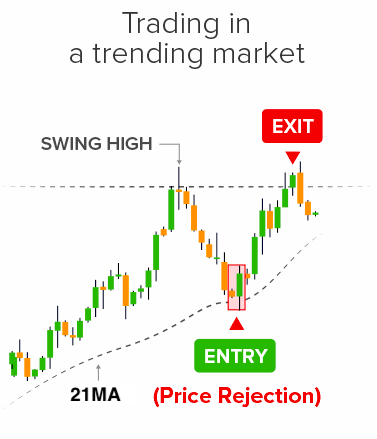Mastering Trend Trading: Simplified Strategies For Riding A Winner
In trading, finding an edge is one of the major keys to success. One powerful approach to trading is trend trading, a strategy that allows you to capitalize on significant market moves and ride them until they reverse. This method thrives on simplicity and effectiveness, making it a go-to choice for many traders. In this article, we will simplify the art of trend trading, breaking down the setup, identification, entry points, and risk management strategies needed to navigate and become profitable with trend trades.
Identifying Trends: The Starting Point
Trend trading begins with identifying trends, and these often emerge following a consolidation or ranging phase. Think of consolidation as a resting period where prices move within a defined range or base. When prices eventually break out of this range, a new trend begins. The duration of this consolidation can vary; it's often represented by 50, 100, or 200 bars, depending on your chosen time frame. To spot trending assets, focus on the breakout above or below key moving averages, such as the 50/100/200 day moving average. A breakout from these levels serves as a strong signal that a trend is underway.
Another valuable method is to analyze price action for higher highs and higher lows in an uptrend and lower highs and lower lows in a downtrend. This is also known as market structure, which is valuable knowledge in determining how price will move in the future. These turning points, known as pivots, can also be gauged by observing the slope of the same moving averages mentioned earlier: 50/100/200MA. Steeper slopes indicate stronger trends. Keep in mind that consolidation doesn't always lead to an upward breakout; be prepared for movements in either direction.
Measuring Trend Strength: The Heart of the Strategy
To effectively trade trends, you must measure their strength. This involves considering two critical factors: price position and momentum.
Strong Trend: This is characterized by a rising price that consistently stays above a fast moving average and avoids closing below it. I prefer to use the 8-period moving average as a fast MA. However, a trend can still be considered strong if it is holding the 20MA.
Healthy Trend: In this scenario, the price rises but regularly finds support at 50MA and rebounds.
Weak Trend: Here, the price is on the rise but often penetrates the 21MA and 50MA before finding support at the 200MA.
Momentum, determined by the length of candles, is another crucial indicator. Longer candles signify higher momentum and a stronger trend, while shorter candles indicate weaker momentum and the potential for a trend reversal.
Finding trend trade Entry Points: The Crucial Step
Entering a trend at the right moment is crucial. There are two primary methods for entering trades effectively:
Breakout Entry
On a daily timeframe, for early long trades, consider the following conditions:
Price breaks above the 20-day high.
Price is above 21MA.
Volume exceeds the 20-day average (this point is often overlooked - Always check volume)
Initiate a buy order one tick above the breakout candle's high.
Pullback Entry
Entering a Trend on the 21MA Pullback
An equally reliable approach is to wait for the first pullback to 21MA. If the price gets rejected by the 21MA and subsequently breaks the previous day's high, enter long one tick above the previous day's high. Set a stop loss below the 21MA or below the low of the previous day's candle whose high was broken.
An even more favorable scenario occurs when the current candle breaks the previous day's low, penetrates 21MA, and then breaks the previous day's high - this presents a stronger entry opportunity with higher success potential as price does what I call a “look below” the recent lows and the 21MA. If there is no continued selling interest below the 21MA, buyers pounce on this opportunity which generates a very strong signal. Note that in this scenario, be sure to wait for the full candle closure. This means an entry near end of day if trading on the daily timeframe chart.
Riding the Trend: Staying in the Game
Once you're in a trend, the next step is to stay in the game and maximize your gains. In an uptrend, watch for pullbacks on low volume to the fast MA and for price rejection by the fast MA. Keep an eye out for bullish reversal candlestick patterns on any pullback. To learn more about various candlestick patterns and trend trading strategies, check out the Options Mastery Course.
In a downtrend, the same principles apply. Look for pullbacks to the fast MA and price rejection, while being alert to bearish reversal candlestick patterns.
Managing Risk: Protecting Your Capital
Effective risk management is at the core of successful trend trading. In an uptrend, set your initial stop loss below the low of the last pivot or 21MA. In a downtrend, position it above the last pivot high or 21MA. As the trend progresses, consider trailing your stop loss using market structure to protect your gains.
In conclusion, trend trading, while simple in concept, requires discipline, patience, and a keen eye for spotting opportunities. By identifying trends effectively, measuring their strength, finding well-timed entry points, and managing risk, you can navigate the world of trading with confidence. If you are looking for additional trend trading ideas, or want to see how we personally trade them, check out our Swing Trade Radar. We always include a full write-up of the trade idea as well as entry and exit, which many traders find incredibly useful. When trend trading, remember that a trend may continue until it shows signs of bending or reaches a minimum 1:2 risk-reward ratio. So, whether you're looking to ride the upward wave or profit from a market downturn, trend trading can be a valuable addition to your trading toolkit.


